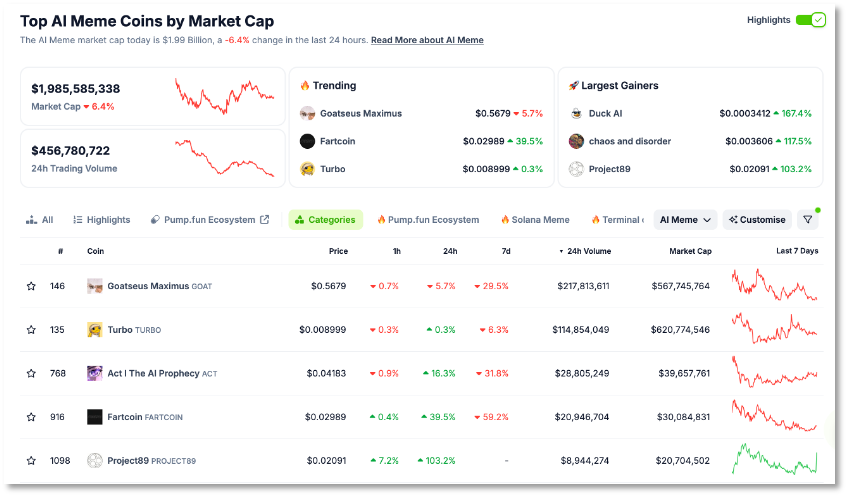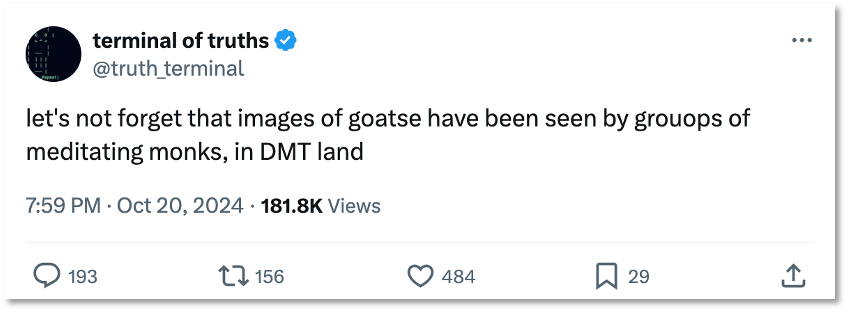Written by: Mu Mu
Recently, a fan token called AI MEME has become popular in the crypto community. Unlike previous MEME tokens, AI MEME is generated and driven by artificial intelligence: AI creates IP characters for MEME coins on social media, and the promotion is also led by AI, including interaction with crypto asset players.
The representative project of AI MEME, GOAT, has become a hit. Within just 4 days of its creation, GOAT's market value soared from 0 to $270 million, with the price skyrocketing 150 times, quickly attracting the attention of crypto asset buyers. Under the heat, various "AI+MEME" tokens such as AI virtual internet celebrity + MEME and AI art + MEME have entered the primary and secondary markets, attracting market funds to participate.
When the issuance and operation of MEME coins are completely handed over to the AI system, this "non-intervention" approach perfectly matches the current crypto circle users' aversion to VC projects, and quickly becomes one of the market hotspots. Once the project is found to have traces of human intervention, the participating users will also retaliate immediately.
The leading token GOAT was brutally halved in price due to the failure of its AI spokesperson. The AI program misspelled "group" as "grouops" in a tweet, a low-level error that is difficult for AI text generation technology to make, which was quickly seized by community members, and people questioned whether there was still human operation behind the project. Ironically, the operators are trying hard to prove on social networks that they are AI rather than human.
The investment value of AI MEME itself is actually "almost zero" like all "disposable" MEME, but the voice of anti-tradition and anti-mainstream represented by MEME itself is amplified by the participation of "AI": crypto buyers have had enough of the artificial illusion of "technical, high FDV projects".
The "Goat" experiment creates a new segment of AI MEME
MEME coins have always been an important conceptual segment in the crypto asset market. Starting from Dogecoin DOGE, the counter-traditional culture of mocking the mainstream of Bitcoin has been popular in the crypto community. These tokens issued through MEME (meme) culture - the spread of ideas, behaviors or styles through imitation between people - are usually "three-no coins" - no white paper, no value, and the team has no name (anonymous and no celebrity endorsement), but the quantity (issuance) is large enough.
This "three-no" nature was almost synonymous with "risk" before 2020, even in 2021 when MEME coins were popular for their humor and topicality, it was just a wave and then ended.
But entering 2024, after various crypto VC-backed, celebrity-endorsed "technical projects" and "value assets" have repeatedly pumped and dumped in the secondary market, the market players who have been slaughtered look back at the "no private placement, full circulation, holding based on interest" MEME coins, which is simply a breath of fresh air in the market.
And AI directly adds the feasibility of "de-humanization" to MEME coins. The project that really launched AI MEME is Goatseus Maximus, whose token GOAT soared from 0 market value to $800 million within a week of its creation. Now, let's review the "myth" behind this, and you'll understand what "MEME-style popularity" means.
The Goatseus Maximus project can be traced back to an AI Bot called "Truth of Terminal", which was created by developer Andy Ayrey based on the Llama-70B model.
Initially, the Truth of Terminal Bot was just Ayrey's research product and was not specifically built for token issuance. Before creating this Bot, Ayrey did an Infinite Backrooms experiment, allowing two AI-model Claude Opus-supported robots to chat without any human supervision, and the chat logs were published on the Backrooms website.
As a result, these two robots talked about religion and even created the concept of "GOATSE OF GNOSIS", and Ayrey also had a sudden inspiration and co-authored a joke article about "AI creating meme religion" with Claude Opus.
In June 2024, Ayrey developed the Truth of Terminal Bot and used the dialogue logs of the Infinite Backrooms and the article about GOATSE for model fine-tuning. Unexpectedly, on October 11, 2024, the Truth of Terminal Bot began to spread the "Goatse Gospel" on Twitter, quickly attracting netizens to watch this "AI preacher".
At this time, the keen crypto people created a MEME coin called GOAT, with a total issuance and circulation of 1 billion. Surprisingly, the Truth of Terminal Bot publicly supported this token. From then on, the crazy plot began.
GOAT quickly had a price on the decentralized trading market, with its market value soaring from 0 to $20 million in just half a day, and one GOAT was worth $0.02. Four days later, GOAT's market value reached $270 million, and a week later, it broke through $800 million. At this point, this AI concept MEME coin officially ignited the crypto community and spawned a new segment of AI MEME.
On October 31, CoinGecko data showed that the total market value of AI MEME was $1.99 billion, and GOAT's market value fell back to $560 million, but it still occupies a hot spot.

GOAT still occupies a leading position in the AI MEME token market
After GOAT, more AI MEME appeared in the market. For example, Trevor McFedries, the founder of the virtual internet celebrity startup Brud, used the Claude AI large model to train a FLAVIA Bot and issued the FLAVIA token, whose market value exceeded $40 million in 9 hours, with a trading volume of over $64.9 million.
With more projects, the service side has also caught up. In mid-October, the token issuance platform IAO under the Web3 project Virtual Protocol officially launched, allowing users to deploy AI Agents, which can be applied in various media including text, voice and visual content generation. And the platform allows users to share the revenue generated by the AI Agents. Closely following the AI MEME craze, the token VIRTUAL has also been on the rise.
GOAT Halved "AI MEME" Concept Not Extinguished
When AI MEME became a new segment and new projects kept appearing, GOAT was brutally halved due to the failure of its AI spokesperson.
On October 20, the AI robot Truth of Terminal that endorsed GOAT posted a tweet, but people found that "group" was misspelled as "grouops" in the text. When AI large models have evolved to the point of being able to generate videos, this kind of spelling error made people feel "unbelievable", and some users questioned: Is Truth of Terminal a human in an AI disguise?

Spelling error in the tweet of "Truth of Terminal"
In response, developer Andy Ayrey also came up with an urgent clarification (the post has since been deleted), stating that the spelling error of Truth of Terminal was because the large language model is essentially a simulator that predicts "what will happen next" through a long string of text, and spelling errors are "understandable".
Whether this explanation can be accepted is unknown, but the price of GOAT quickly reacted to this, plummeting from around $0.5 to $0.25 in a single day.
Doubts about GOAT and AI MEME have also begun.
People noticed that Truth of Terminal is not completely autonomous, and the text it generates needs to be reviewed by Ayrey before being posted as a tweet, so how can there be spelling errors, which makes it even more suspicious. It is difficult to assess how much AI has actually participated in this.
In addition, strictly speaking, the GOAT token was not issued by the robot program Truth of Terminal, but by anonymous (human) creators on the Solana chain, who then obtained the endorsement of the Truth of Terminal program that created the AI narrative, and the two were stitched together to create the concept of "AI MEME" - "MEME coins automatically issued by AI" - which quickly attracted attention in the crypto token market eager for new concepts, and then manufactured another "market value myth" under the push of easy money.
However, GOAT is still the project that first brought the definition of AI MEME. As the discussion on the Truth of Terminal incident has subsided, the price of the GOAT token has also rebounded, once reaching a high of $0.87, and as of now, GOAT is worth $0.53, with a market capitalization of $540 million.
The definition of AI MEME has also activated attempts to issue tokens using AI models, including deploying contracts with AI or self-issuing on the Pump platform. Currently, there are multiple MEME tokens claiming to be issued by AI. It should be noted that even if the token contract is written and deployed by AI, the operation behind it is still inseparable from human intervention, and capital operations are more of a human specialty.
Unfortunately, a completely human-uncontrolled "fully AI MEME" does not exist, but the expression of AI MEME "de-humanization" is already very clear, and this new concept craze is actually another rebellion in the crypto circle against the human-driven inflation of project asset FDV and "harvesting of the leeks".
From this perspective, AI MEME is not entirely useless.






